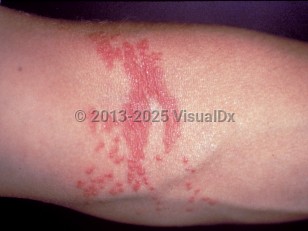Jellyfish sting in Adult
Alerts and Notices
Important News & Links
Synopsis

The most common envenomations encountered in aquatic environments by humans are by members of the phylum Cnidaria. This phylum includes jellyfish, Portuguese man-of-war, sea anemones, and corals. The common element to all of these groups is the presence of nematocysts or stinging capsules that contain various toxins. Injuries caused by these organisms range from mild irritations to painful, serious injuries with tissue necrosis—sometimes fatal.
Jellyfish and Portuguese man-of-war (Physalia physalis) injuries initially present with sharp burning pain followed rapidly by development of erythematous welts in whip-like patterns on the body. These subside within hours, but resolve to hyperpigmentation in minor cases or bullae and necrosis in severe cases. Systemic symptoms may accompany severe P. physalis injuries and include nausea, abdominal cramps, irritability, chest tightness, and dyspnea.
Stings by Chironex fleckeri, known as box jellyfish or sea wasp (an enormous jellyfish found in tropical Australian waters), are typically severe. The lesions have a characteristic frosted appearance to them due to a dermatonecrotic toxin. Commonly, exposure is fatal due to hemolytic and cardiotoxic toxins. See also Hawaiian box jellyfish sting and lion's mane jellyfish sting.
Sea anemone dermatitis is caused by exposure to one of several species and usually results in conditions similar to allergic contact dermatitis, but differs in that the symptoms occur within minutes of contact.
Exposures to coral may be quite mild and result only in irritation and pruritus. Stings from fire corals, which are not true corals, are painful initially and result in papular and pustular eruptions that can progress to tissue necrosis.
Jellyfish and Portuguese man-of-war (Physalia physalis) injuries initially present with sharp burning pain followed rapidly by development of erythematous welts in whip-like patterns on the body. These subside within hours, but resolve to hyperpigmentation in minor cases or bullae and necrosis in severe cases. Systemic symptoms may accompany severe P. physalis injuries and include nausea, abdominal cramps, irritability, chest tightness, and dyspnea.
Stings by Chironex fleckeri, known as box jellyfish or sea wasp (an enormous jellyfish found in tropical Australian waters), are typically severe. The lesions have a characteristic frosted appearance to them due to a dermatonecrotic toxin. Commonly, exposure is fatal due to hemolytic and cardiotoxic toxins. See also Hawaiian box jellyfish sting and lion's mane jellyfish sting.
Sea anemone dermatitis is caused by exposure to one of several species and usually results in conditions similar to allergic contact dermatitis, but differs in that the symptoms occur within minutes of contact.
Exposures to coral may be quite mild and result only in irritation and pruritus. Stings from fire corals, which are not true corals, are painful initially and result in papular and pustular eruptions that can progress to tissue necrosis.
Codes
ICD10CM:
T63.621A – Toxic effect of contact with other jellyfish, accidental, initial encounter
SNOMEDCT:
274920002 – Jellyfish sting
T63.621A – Toxic effect of contact with other jellyfish, accidental, initial encounter
SNOMEDCT:
274920002 – Jellyfish sting
Look For
Subscription Required
Diagnostic Pearls
Subscription Required
Differential Diagnosis & Pitfalls

To perform a comparison, select diagnoses from the classic differential
Subscription Required
Best Tests
Subscription Required
Management Pearls
Subscription Required
Therapy
Subscription Required
References
Subscription Required
Last Updated:10/04/2017
 Patient Information for Jellyfish sting in Adult
Patient Information for Jellyfish sting in Adult
Premium Feature
VisualDx Patient Handouts
Available in the Elite package
- Improve treatment compliance
- Reduce after-hours questions
- Increase patient engagement and satisfaction
- Written in clear, easy-to-understand language. No confusing jargon.
- Available in English and Spanish
- Print out or email directly to your patient
Upgrade Today

Jellyfish sting in Adult

